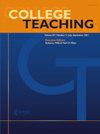消除前排:聊天式教学如何促进学生参与
Q3 Social Sciences
引用次数: 1
摘要
摘要 现在有一种采用以学生为中心的学习(SCL)来提高学生参与度和积极性的教学方法。由于 COVID-19 的流行,我们过渡到了远程教学,这为我们提供了一个观察学生如何利用聊天功能自主学习的机会。我们使用定性内容分析法对 2020-2021 学年期间 53 名研究生的聊天数据进行了分析。研究结果显示,学生们利用聊天来激励、鼓励和主动学习。本文章由计算机程序翻译,如有差异,请以英文原文为准。
Eliminating the Front Row: How Teaching in the Chat Fosters Student Engagement
Abstract There has been a movement toward pedagogies that employ student-centered learning (SCL) to increase student engagement and motivation. Our experience transitioning to remote teaching due to the COVID-19 pandemic provided an opportunity for us to observe how students used the chat function to take ownership of their learning. We used qualitative content analysis to analyze data from 53 graduate students’ chats over the course of the 2020-2021 academic year. Findings revealed students used the chat for motivation, encouragement, and active learning.
求助全文
通过发布文献求助,成功后即可免费获取论文全文。
去求助
来源期刊

College Teaching
Social Sciences-Education
CiteScore
1.50
自引率
0.00%
发文量
33
期刊介绍:
College Teaching provides an interdisciplinary academic forum on issues in teaching and learning at the undergraduate or graduate level. The journal publishes three kinds of articles. Regular, full-length articles of up to 5,000 words reporting scholarship on teaching methods, educational technologies, classroom management, assessment and evaluation, and other instructional practices that have significance beyond a single discipline. Full-length articles also describe innovative courses and curricula, faulty development programs, and contemporary developments. Quick Fix articles, up to 500 words, present techniques for addressing common classroom problems. Commentaries, up to 1,200 words, provide thoughtful reflections on teaching.
 求助内容:
求助内容: 应助结果提醒方式:
应助结果提醒方式:


